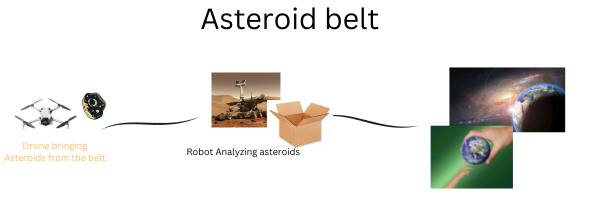Colonization of the Asteroids Belt 2.0
Grade 9
Presentation
No video provided
Problem
Phase one of the project underscored the dire consequences of gold mining, which annually contaminates an estimated 1,000 tons of water with mercury and cyanide, posing significant risks to aquatic life and human health. Additionally, nickel and copper extraction contribute to air and water pollution, with nickel mining alone releasing approximately 2.8 million tons of sulfur dioxide into the atmosphere each year. These activities not only harm ecosystems but also displace communities, with over 1,000 cases reported globally of people forcibly removed from their lands due to mining operations. As Earth's resources diminish, the imperative for sustainable alternatives intensifies to avert further ecological degradation. Failure to address these issues could accelerate Earth's transformation into a barren landscape akin to Mars, highlighting the urgent need for responsible resource extraction practices.
Method
Situated between Mars and Jupiter, approximately 179.5 million kilometers from Earth, the asteroid belt emerges as a promising frontier for resource extraction, boasting an estimated value exceeding $700 quintillion worth od gold,and include coper,and nikel.Bolstered by the successes of previous Mars rover missions such as Sojourner, Spirit, Opportunity, Curiosity, and Zhurong, human endeavors toward Martian colonization offer a strategic vantage point for asteroid mining. Following the establishment of a Mars colony last year, meticulously prepared with the assistance of YZ-Ranger, attention now pivots toward the next phase: asteroid exploration and mining. Guided by the advanced capabilities of the YR-Droner, equipped with sophisticated tools and sensors, this robotic explorer navigates the asteroid belt, conducting compositional analyses and collecting samples, with a keen focus on valuable materials such as gold, nickel, and copper. Facilitating seamless communication between the YR-Droner and Earth-based scientists, informed decisions regarding sample collection are made, ensuring the optimization of resource acquisition. Upon the completion of its mission, the YR-Droner returns to Mars, where the YZ-Ranger aids in evaluating sample worth before their safe transport to Earth. Beyond the realm of scientific advancement, this initiative serves as a beacon for educational endeavors, illuminating the synergistic potential of robotics, coding, and technology in the realm of space exploration, propelling humanity toward a future characterized by sustainable resource acquisition beyond the confines of Earth.
Analysis
YZ-Ranger is upgrading and achieving the ability of moving automatically. Scientist has programed it a code to follow and complete his mission on mars. YR-droner is being controlled by advanced AI codding using the codding Language of Python.
Conclusion
The idea may look like science-fiction,but when reviewing the studies and the technology we have reached as humans, We think this project is applicable and could save this planet! We hope that in the near future we can share our project globally, showing the whole world the importance of saving this planet.
Acknowledgement
We extend our heartfelt appreciation to all individuals and organizations who have contributed to the realization of this project. Special thanks to the dear judges who took the time to evaluate and provide feedback on our project during the science fair. We are grateful for the guidance and support provided by our mentors, educators, and advisors, whose insights and encouragement have been invaluable throughout the journey. We look forward to continued exploration and innovation as we strive to address the challenges of resource scarcity and environmental sustainability for the benefit of future generations.

